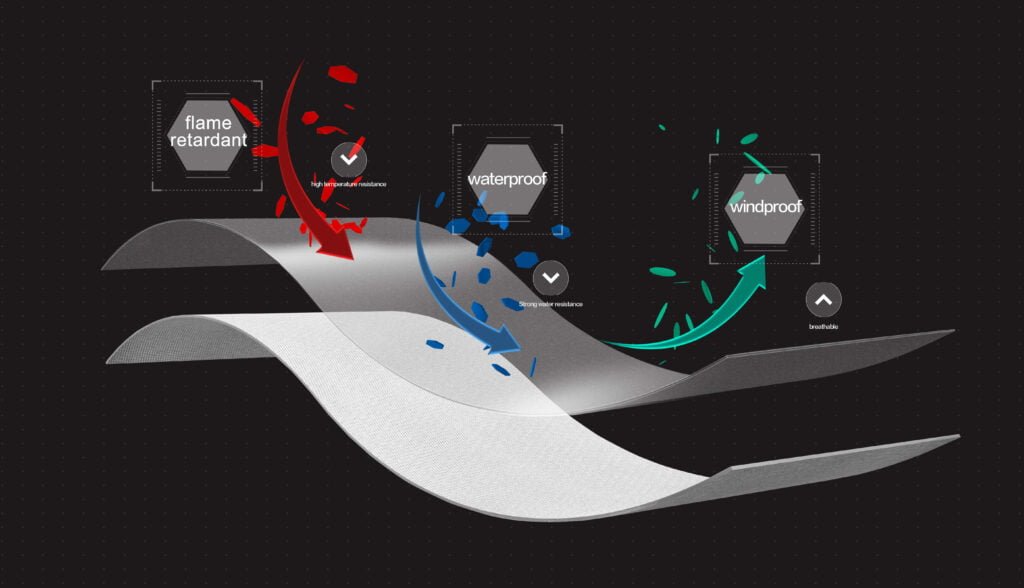Flame Retardant(FR)
Fabrics
Get instant quotes on the custom FR fabric. Produce 100% cotton, C/N 88/12, CVC, and T/C fabric. Stand on EN11611, EN11612, NFPA2112, etc.
About LEVITEX® FR Fabric
LEVITEX® Flame Retardent Fabric features a Stability composition
LEVITEX® Flame Retardant fabrics are used to make clothing that protects workers from serious injury when struck by arcs, flames, or molten metal. These self-extinguishing fabrics will not continue burning after the heat source has been removed and don’t melt even if exposed at high temperatures.
FR Fabric Featured

100% Cotton, C/N 88/12, CVC, T/C
| Feature | Description |
|---|---|
| Compositon | 100% Cotton, Rich-cotton, Cotton/Nylon, Polyester/Cotton, both of all can be flame-resistant. |
| Lead time | 20 - 60 days. (For regular fabrics are quickly delivered in 20 days, for customized fabrics need 45 to 60 days.) |
| Weight | 150 - 600 GSM |
| FR treatment Type | Tetrahydroxymethyl Phosphorus Chloride (THPC) |
| Standard | EN11611, EN11612, NFPA2112 |
| Washing Times | 50 - 100 times. (LEVITEX technology fabric makes it up to 100 times) |
| Multifunctional Processing | LEVITEX can combine different functions such as oil resistant, water repellency, acid and alkali resistant, antistatic, moisture wicking, water pressure resistant, anti-mosquito, and Teflon on the same flame resistant fabric. |
FR Fabric Materials
100%
Cotton
Polyester/
Cotton
Cotton/
Nylon
Customers Also Ask
Q&A
What does FR stand for?
Flame resistant fabrics are designed to self-extinguish when the ignition source is removed. This makes them a safer choice for workers in
What is ATPV?
Arc Thermal Protective Value (ATPV) is the rating of the Arc burn protection capability of a garment. The higher the ATPV, the more protection the garment gives because it has a higher resistance to catching on fire. The ATPV is expressed in calories per cm2 and represents the thermal exposure from an electric arc that will create a second-degree burn in human tissue. If the ATPV cannot be calculated because the fabric breaks open, the energy causing the fabric to break open is expressed as the Energy of Breakopen Threshold (EBT). The higher the value, the greater the protection the garment offers.
What are PPE Categories?
The NFPA 70E safety standard specifies four PPE categories, based on specific job tasks. Category 1 allows single-layer FR arc-rated shirts, pants or coveralls, while Category 4 requires a FR arc-rated shirt and pants, plus a double layer switching coat and pants. All garments for PPE 1 through 4 MUST be Arc-Rated.
Who wears Flame Resistant (FR) clothing?
Flame resistant clothing is a type of clothing that helps to protect the wearer from catching on fire. This type of clothing is often worn by people who work in hazardous environments, such as those who work with electric arcs, flash fires, and combustible dust explosions. Flame resistant clothing can help to protect the wearer from burns, and can also help to reduce the amount of heat that is transferred to the body. As a result, this type of clothing is an important part of personal protective equipment for many workers.
Is FR mean Flame-resistant or Flame-retardant?
Resistant is defined as a material that is inherently resistant to catching fire (self-extinguishing) and does not melt or drip when exposed directly to extreme heat. Retardant is defined as a material that has been chemically treated to self-extinguish (a type of fabric finishing), Flame-retardant products are designed to slow down ignition or combustion.
Why used C/N 88/12 for flame resistant?
In the cases of 88/12 FR Fabric, it's a very small amount blended or woven tightly on the inside of FR Cotton Fabric. The combination produces an excellent product for maximum protection. Nylon is a synthetic fiber that is made from polyamides. It is a thermoplastic and can be melted down and reformed multiple times, making it a good choice for clothing that needs to be flame-resistant. However, if too much nylon is present in the fabric, it can make the fabric more flammable. That's why the 88/12 FR Fabric is a good choice for safety clothing- the small amount of nylon woven into the cotton fabric makes it flame-resistant without making it too flammable.
What is NFPA® 2112?
The NFPA® 2112 standard provides minimum guidelines and design criteria for Flame Resistant (FR) garments. The standard calls for flash fire testing to be conducted at three seconds with a pass/fail rate of 50% total body burn under ASTM F1930 testing protocals. The purpose of the standard is to protect individuals from potential flash fires in areas where flammable gases, vapors, or combustible dusts may be present.
What is an ARC Rating?
An ARC Rating is a measure of the protective characteristics of different fabric for the workplace. It stands for Arc Rating Coefficient, and measures how easily an electric current will flow through the fabric. The higher the ARC rating, the greater the protection from electric shock.
ARC ratings are often displayed on clothing labels as ATPV (Arc Thermal Performance Value) or EBT (Energy Breakthrough Temperature). They are determined by a Hazard/Risk Assessment, and the resulting HRC (Heat Resistance Classification).
How do normal fabrics react to ignition?
Normal fabrics will ignite when coming into contact with an ignition source, and the flame will spread quickly through the fabric. The fabric will continue to burn until it is extinguished or all flammable material is consumed.
What level of FR clothing protection is typically needed?
Flame resistant clothing is usually chosen based on an employer's own hazard analysis, which determines the right garments for the potential incident energy exposures in a given work environment. Taking into account NFPA standard 70E, Category 1 and 2 workers generally require FRC with an ATPV rating of 8 or higher. Category 1 has a minimum arc rating of 4. This means that the vast majority of electrical trade workers need some level of flame resistant clothing protection.
